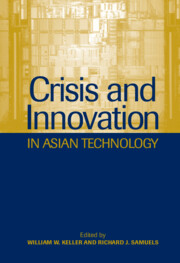Book contents
- Frontmatter
- Contents
- Figures and Tables
- Contributors
- Acknowledgments
- 1 Innovation and the Asian Economies
- 2 Japanese Production Networks in Asia: Extending the Status Quo
- 3 Crisis and Innovation in Japan: A New Future through Technoentrepreneurship?
- 4 Crisis, Reform, and National Innovation in South Korea
- 5 From National Champions to Global Partners: Crisis, Globalization, and the Korean Auto Industry
- 6 Crisis and Adaptation in Taiwan and South Korea: The Political Economy of Semiconductors
- 7 China in Search of a Workable Model: Technology Development in the New Millennium
- 8 Economic Crisis and Technological Trajectories: Hard Disk Drive Production in Southeast Asia
- 9 Continuity and Change in Asian Innovation
- Index
7 - China in Search of a Workable Model: Technology Development in the New Millennium
Published online by Cambridge University Press: 15 December 2009
- Frontmatter
- Contents
- Figures and Tables
- Contributors
- Acknowledgments
- 1 Innovation and the Asian Economies
- 2 Japanese Production Networks in Asia: Extending the Status Quo
- 3 Crisis and Innovation in Japan: A New Future through Technoentrepreneurship?
- 4 Crisis, Reform, and National Innovation in South Korea
- 5 From National Champions to Global Partners: Crisis, Globalization, and the Korean Auto Industry
- 6 Crisis and Adaptation in Taiwan and South Korea: The Political Economy of Semiconductors
- 7 China in Search of a Workable Model: Technology Development in the New Millennium
- 8 Economic Crisis and Technological Trajectories: Hard Disk Drive Production in Southeast Asia
- 9 Continuity and Change in Asian Innovation
- Index
Summary
Like other East Asian countries, China has been undergoing a process of liberalization and of opening to the world economy. During the past twenty years, economic reforms have slowly moved the country as a whole toward a more open, more market-oriented economy, and science and technology (S&T) policies and institutions have been reformed in a similar spirit. Policy makers gradually dismantled a highly centralized and hierarchical model of technological innovation and began replacing it with a more flexible and “bottom-up” system. Leaders at all levels have moved away from a research and development system dominated by central planning and state-owned enterprises to one that increasingly relies on individual innovation and entrepreneurship, while foreign direct investment (FDI) and multinational corporations both play larger roles in Chinese development plans. The openness to a diversity of actors crucially includes both outside actors — multinational corporations (MNCs) — and domestic non-state-owned corporations. China's entry into the World Trade Organization (WTO) promises to consolidate these trends.
At first glance then, China seems to be part of a larger project of the recasting of technology policy within the region. But ironically, in recent years, China's policy has also evolved in ways that bring it closer to technonationalism, at least in some senses of the word.
- Type
- Chapter
- Information
- Crisis and Innovation in Asian Technology , pp. 160 - 186Publisher: Cambridge University PressPrint publication year: 2003
- 14
- Cited by

